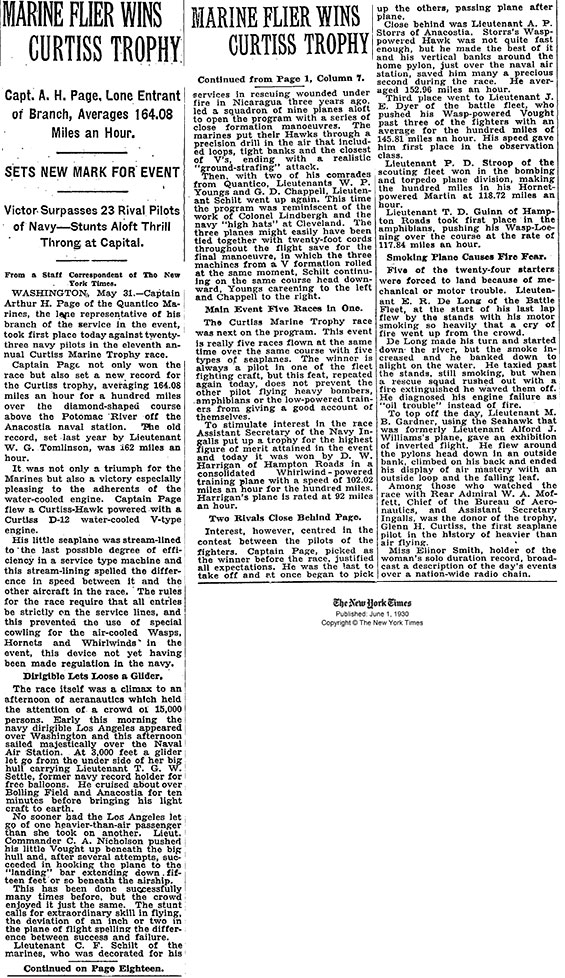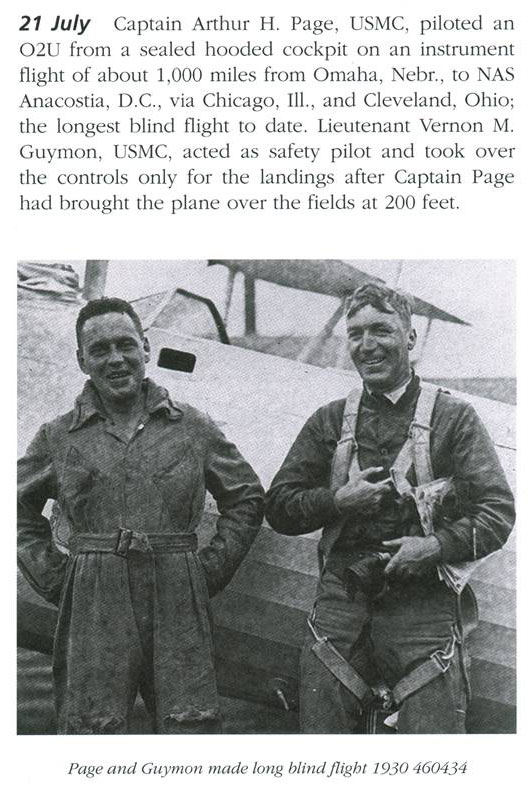|
Captain Arthur Page landed once at Tucson, Friday, February 15, 1929 at 1:30PM. He flew A-7955, a Marine Corps Curtiss OC-2 (Falcon). He carried Sgt. F.G. Saucedo. Based at Quantico, VA, they were eastbound from San Diego, CA to El Paso, TX. They left no remarks in the Register to suggest a reason for their flight through Tucson or the identification of their ultimate destination.
They were in a flight of three with two other Curtiss Falcons, A-7671 and A-7959, flown by Lt. L.L. Pugh and Lt.Col. T.C. Turner, respectively. They remained in Tucson overnight, departing next day, February 16th, at 8:30AM.
During the short period we see Page, he achieved two Golden Age records. For the first, about a year after his landing at Tucson, Page represented the Marine Corps and flew in the Curtiss Marine Trophy Race for seaplanes. He gained notoriety for for his win of that event, flown on May 31, 1930. The airplane he flew was a modified Curtiss F6C-3 Hawk with a Curtiss D-12 engine.
His 164MPH speed was two MPH faster than the previous year, when W.G. Tomlinson reached 162MPH in the same airplane. Below, his victory was documented in the NAVAIR reference in the right sidebar. The trophy was presented by Glenn Curtiss in one of his last public appearances before his death.
A.H. Page, Curtiss Marine Trophy Race Victory, May 31, 1930 (Source: NAVAIR)
 |
Page's May 31, 1930 victory in the Race (as the sole Marine Corps entrant), was also reported in detail in The New York Times June 1, 1930, below. Note mention of Register pilot W.G. Tomlinson in this article. Tomlinson had won the 1929 Race on May 18th that year. Also mentioned was Christian Schilt, Marine pilot and Medal of Honor winner, and J.E. Dyer. Mention of other Register pilots included Charles Lindbergh, Matthias B. Gardner, C.A. Nicholson, A.P. Storrs, and Elinor Smith.
The New York Times June 1, 1930 (Source: NYT)
 |
Two months later, he and fellow Marine Corps pilot V.M Guymon (not a Register pilot) executed the longest "instrument flight" to-date. They are pictured below left from the NAVAIR reference in the right sidebar. Their itinerary was described in the text.
A.H. Page, Left, July 21, 1930 (Source: NAVAIR)
 |
It's worth discussing here what is meant by "instrument flight," and how several of our Register pilots were involved in the science and art of taking off, flying and landing an aircraft by reference to instruments only, and without reference to guidance outside the cockpit.
Before Page and Guymon's flight, on September 1929, Jimmy Doolittle flew
an airplane from the ground, around a planned course, and
returned it successfully to a landing by reference to instruments
alone. Even though he was under a canvas
hood and could not see out of the cockpit, he had a
check pilot with him in the other cockpit who could see. Critically, Doolittle flew on a clear day and was not solo.
Similarly, Page and Guymon flew the same way, only for a longer period, with cross-country navigation added to Page's work load. In the photo at left, you can see the rear edge of Page's canvas hood in the very upper left corner of the image. The instrument he used is exhibited in Page's hand in the image below, right from Popular Aviation (PA), November, 1930. He also wore a specially-made leather helmet with ear phones.
Popular Aviation, November 1930 (Source: PA)
 |
But, a couple of years later, on May 9, 1932, Register pilot Albert Hegenberger piloted
the very first official solo blind instrument flight. The key
words here are 'official' and 'solo'. Let me explain.
Thompson Trophy Race, Kingsport, TN Newspaper, August 24, 1930 (Source: newspapers.com)
 |
Earlier, in 1926 Howard
Stark (not a Register pilot) developed his "1-2-3 System" of blind flying
by reference to the turn coordinator. Stark
flew many unofficial, straight and level blind flights over
the Connecticut hills carrying mail between New York
and Boston. Even though the enroute sections of his flights were performed blind, the takeoffs and landings were in visual conditions, with landmark references outside the cockpit, on the ground.
Hegenberger, however, passed the hammer test by making
his 'official' 1932 flight 'solo.' The flight was documented in Popular Aviation, March, 1934 (PDF 1.9Mb) at the link. Note that the article suggests that Hegenberger also flew under a hood, but he was solo. This " belt & suspenders" action guaranteed that he could not see the ground until he was at his destination. If you are an instrument-rated pilot and read the linked article, you will be amused at how little has changed over the years regarding the mechanism of the instrument approach. Use of Global Positioning System satellites has changed everything now, but the same principles still apply.
Another Register pilot you should know was a key representative during the early promulgation (ca. 1934 and onward) of instrument flying science and techniques to both military and commercial flyers. His name is Robert W. Henderson, and his pilot log books, downloadable at his link, document his work with military and commercial pilots in this regard. His efforts to roll out instrument flight techniques made commercial and military aviation more safe and reliable.
A month after he flew his long instrument flight, Page entered the first Thompson Trophy Race that was run in 1930. It was part of the National Air Races held at Chicago, IL August 23-September 1st that year. Page, the only military pilot in the field, flew a Curtiss XF6C-6 Hawk, below. The Bureau Number of the airplane was A-7147, and it wore race number 27 in the Thompson Race. Below it is pictured in Popular Aviation (PA), November 1930.
Popular Aviation, November 1930 (Source: PA)
 |
This was the same airplane that won the 1928 and 1930 Curtiss Marine Trophy Races, but with modifications. The floats were removed and replaced by wheels with streamlined pants. And the lower wing was removed, converting it to a monoplane. The Curtiss D-12 engine was replaced with a 700HP supercharged Curtiss Conqueror engine with a new cowling. The modified airplane had a top speed potential of 250MPH. Race preparations, contestants and prizes were documented in the news article at left.
Sadly, near the end of the race, Page crashed while in the lead. He was doing well, taking an early lead and, after several laps, he passed or lapped the entire field. As Page approached the home pylon for lap seven, he suddenly pulled up and out of the race and than slid off on the left wing, nosed down and crashed in sight of the grandstands. He died of injures the next day.The investigation concluded that carbon monoxide had leaked into the cockpit and caused him to lose consciousness.
Page's death pointed out what many in the military had felt about air racing: the technical advances resulting from the sport did not justify the growing number of fatalities. The Navy withdrew from air racing competitions. This decision was not received favorably by Navy pilots. But, with the U.S. in the throes of the Great Depression, there was no sponsorship money to support the events.
According to an online obituary for Page's son, his father had a busy but short life. Page's assignments in the 1920's took the family overseas to Santa Domingo, Guam, Haiti and China.
---o0o---
THIS PAGE UPLOADED: REVISED:
|







